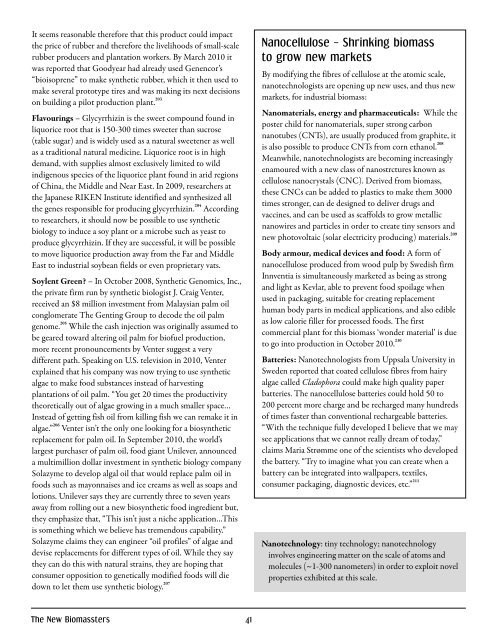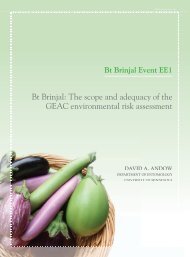English - pdf - 2145 Kb - Biosafety Information Centre
English - pdf - 2145 Kb - Biosafety Information Centre
English - pdf - 2145 Kb - Biosafety Information Centre
- No tags were found...
Create successful ePaper yourself
Turn your PDF publications into a flip-book with our unique Google optimized e-Paper software.
It seems reasonable therefore that this product could impactthe price of rubber and therefore the livelihoods of small-scalerubber producers and plantation workers. By March 2010 itwas reported that Goodyear had already used Genencor’s“bioisoprene” to make synthetic rubber, which it then used tomake several prototype tires and was making its next decisionson building a pilot production plant. 203Flavourings – Glycyrrhizin is the sweet compound found inliquorice root that is 150-300 times sweeter than sucrose(table sugar) and is widely used as a natural sweetener as wellas a traditional natural medicine. Liquorice root is in highdemand, with supplies almost exclusively limited to wildindigenous species of the liquorice plant found in arid regionsof China, the Middle and Near East. In 2009, researchers atthe Japanese RIKEN Institute identified and synthesized allthe genes responsible for producing glycyrrhizin. 204 Accordingto researchers, it should now be possible to use syntheticbiology to induce a soy plant or a microbe such as yeast toproduce glycyrrhizin. If they are successful, it will be possibleto move liquorice production away from the Far and MiddleEast to industrial soybean fields or even proprietary vats.Soylent Green? – In October 2008, Synthetic Genomics, Inc.,the private firm run by synthetic biologist J. Craig Venter,received an $8 million investment from Malaysian palm oilconglomerate The Genting Group to decode the oil palmgenome. 205 While the cash injection was originally assumed tobe geared toward altering oil palm for biofuel production,more recent pronouncements by Venter suggest a verydifferent path. Speaking on U.S. television in 2010, Venterexplained that his company was now trying to use syntheticalgae to make food substances instead of harvestingplantations of oil palm. “You get 20 times the productivitytheoretically out of algae growing in a much smaller space…Instead of getting fish oil from killing fish we can remake it inalgae.” 206 Venter isn’t the only one looking for a biosyntheticreplacement for palm oil. In September 2010, the world’slargest purchaser of palm oil, food giant Unilever, announceda multimillion dollar investment in synthetic biology companySolazyme to develop algal oil that would replace palm oil infoods such as mayonnaises and ice creams as well as soaps andlotions. Unilever says they are currently three to seven yearsaway from rolling out a new biosynthetic food ingredient but,they emphasize that, “This isn’t just a niche application…Thisis something which we believe has tremendous capability.”Solazyme claims they can engineer “oil profiles” of algae anddevise replacements for different types of oil. While they saythey can do this with natural strains, they are hoping thatconsumer opposition to genetically modified foods will diedown to let them use synthetic biology. 207Nanocellulose – Shrinking biomassto grow new marketsBy modifying the fibres of cellulose at the atomic scale,nanotechnologists are opening up new uses, and thus newmarkets, for industrial biomass:Nanomaterials, energy and pharmaceuticals: While theposter child for nanomaterials, super strong carbonnanotubes (CNTs), are usually produced from graphite, itis also possible to produce CNTs from corn ethanol. 208Meanwhile, nanotechnologists are becoming increasinglyenamoured with a new class of nanostrctures known ascellulose nanocrystals (CNC). Derived from biomass,these CNCs can be added to plastics to make them 3000times stronger, can de designed to deliver drugs andvaccines, and can be used as scaffolds to grow metallicnanowires and particles in order to create tiny sensors andnew photovoltaic (solar electricity producing) materials. 209Body armour, medical devices and food: A form ofnanocellulose produced from wood pulp by Swedish firmInnventia is simultaneously marketed as being as strongand light as Kevlar, able to prevent food spoilage whenused in packaging, suitable for creating replacementhuman body parts in medical applications, and also edibleas low calorie filler for processed foods. The firstcommercial plant for this biomass ‘wonder material’ is dueto go into production in October 2010. 210Batteries: Nanotechnologists from Uppsala University inSweden reported that coated cellulose fibres from hairyalgae called Cladophora could make high quality paperbatteries. The nanocellulose batteries could hold 50 to200 percent more charge and be recharged many hundredsof times faster than conventional rechargeable batteries.“With the technique fully developed I believe that we maysee applications that we cannot really dream of today,”claims Maria Strømme one of the scientists who developedthe battery. “Try to imagine what you can create when abattery can be integrated into wallpapers, textiles,consumer packaging, diagnostic devices, etc.” 211Nanotechnology: tiny technology; nanotechnologyinvolves engineering matter on the scale of atoms andmolecules (~1-300 nanometers) in order to exploit novelproperties exhibited at this scale.The New Biomassters 41











